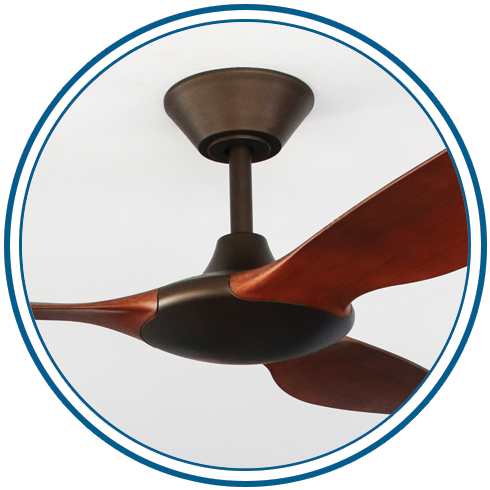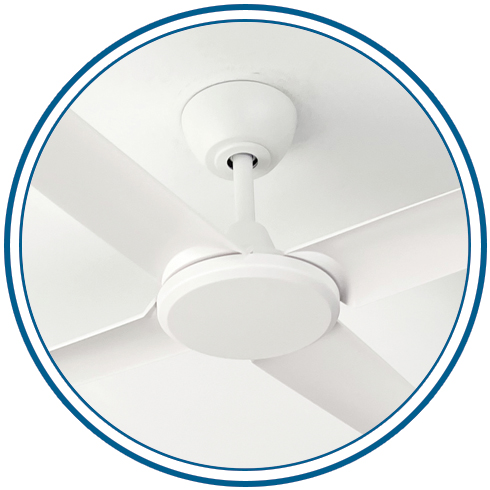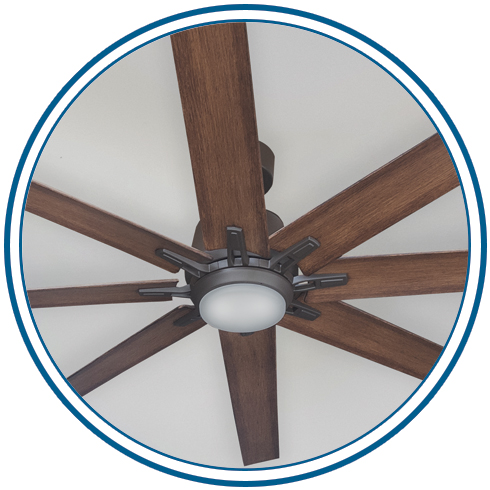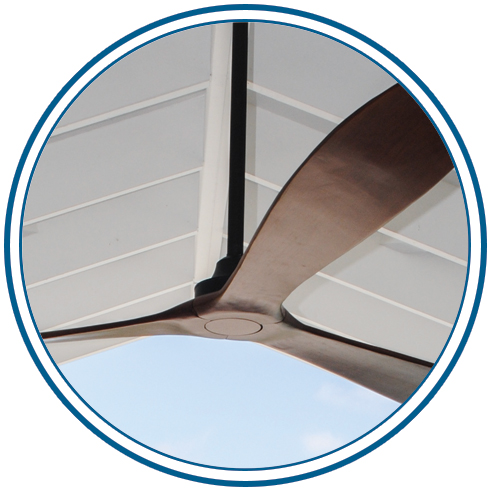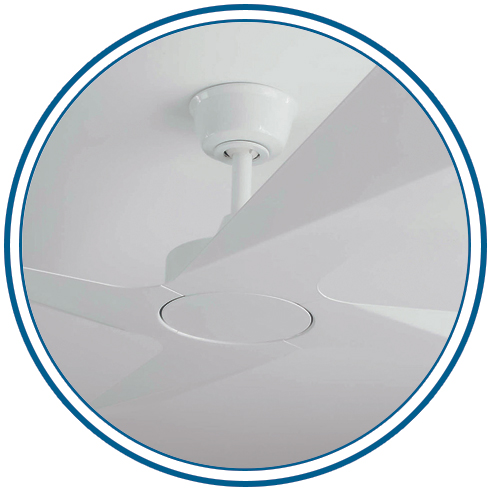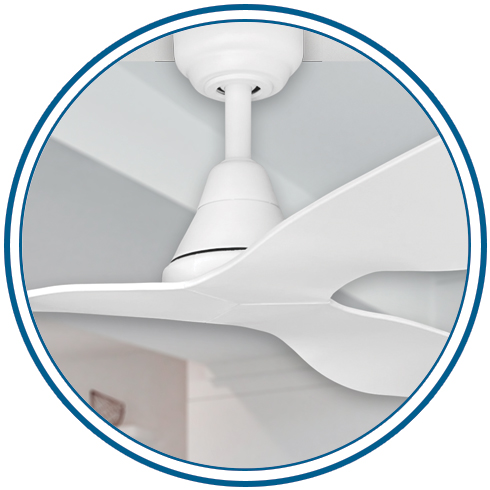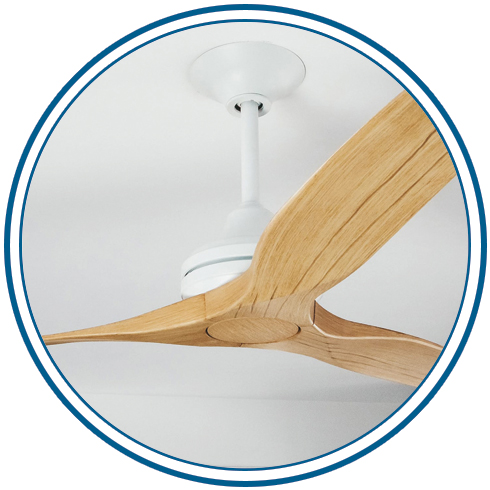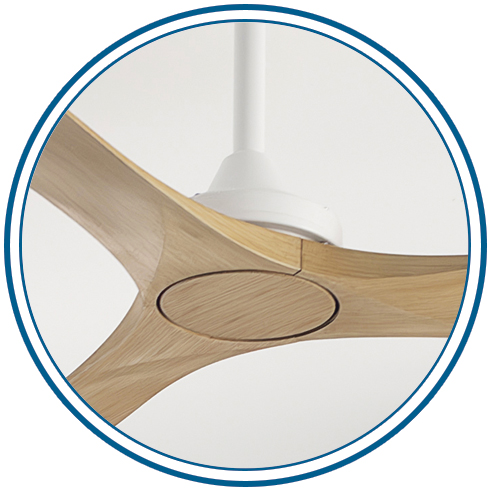Quiet
Quiet Ceiling Fans
Our whisper-quiet ceiling fans are designed and engineered to keep things fresh and tranquil. Your new ceiling fan utilises premium hanger brackets for improved fan stabilisation, high-quality copper windings, and silicone steel stators for smooth and quiet operation, and all moving parts are dynamically balanced (vertically and horizontally) to prevent any unwanted movement.

Choosing a quiet ceiling fan for your space
Everyone wants a quiet ceiling fan. Personal preference, setting and the cooling requirements of your ceiling fan are all factors that affect how quiet your ceiling fan should (or needs to) be.
Some fans are purpose-built to move as much air as possible, some made for sound-sensitive areas like bedrooms, and some are built for their aesthetic appeal. To help you find the right ceiling fan for your space, we’ve broken down the types of noises a fan may make and what you should look for based on your particular needs.
Typically, we can break fan noise down into one of three areas:
- Motor noise
- Blade and wind noise
- Mechanical noise (ticking, creaking, etc.)
Motor noise
Electric motors drive all ceiling fans, with the internal motor being either AC (Alternating Current) or DC (Direct Current).
The AC motor is driven by the household supply of electricity which is 240V at 50Hz. The electricity applied to the copper coils of the motor creates an electromagnet to turn the motor; this will inevitably generate a hum or buzzing noise to some degree.
It is the method and quality of the motor manufacturer that can mitigate this motor noise by using quality components. These include good quality copper windings, silicon steel stators, and high-rated capacitors. These all add cost to produce a good quality motor and contribute to the silent operation of the motor.
DC motors are a relatively new motor technology in ceiling fans and operate differently. The construction of a DC motor uses permanent magnets to drive the motor. The DC motor requires an electronic controller to regulate the current to the motor to push the magnets with pulses at intervals. This method is not only more energy efficient but does not generate a magnetic field like an AC motor, so it is not subject to the same hum or buzz that may occur in an AC motor. DC motors, however, are more expensive to produce due to the magnets and electronics to control them.
For ceiling fans used in a sound-sensitive area, or if you are highly sensitive to the electric hum of a fan motor, you may wish to consider a DC ceiling fan.
For most people, a quality AC ceiling fan will be more than quiet enough – especially once the fan goes above low speed. For most applications, both AC and DC motors will suit.
Blade and wind noise
The purpose of a ceiling fan is to spin its blades against the available air and force it down to create a breeze. The aerodynamics involved in doing this will result in the “whooshing” sound as the fan spins around at velocity.
Generally, the faster a fan spins, the greater the “whooshing” sound. The variables in this are the length of the blade and the shape of the blade. The longer the blade (running at the same RPM), the faster the tip of the blade is travelling and cutting through the air, so more noise. The shape of the blade is a critical factor in the sound the blade makes through the air.
Depending on its shape, it can be efficient or inefficient at moving through the air to force it down. A flat paddle style blade is rather ineffective at moving air. As a flat blade spins, it creates unwanted turbulence behind it which decreases its air movement efficiency and adds to the “whoosh”. Flat blades are a cost-effective way to make a fan blade and usually made from timber.
Today, many fan manufacturers make quieter fans by making blades that have a curve in them. The ThreeSixty Fans Aspire fan is an example of this. By introducing an aerodynamic curve into its ABS polymer blades, it is much more efficient at moving the air in a downward fashion while reducing the amount of turbulence behind the blade as it moves at speed.
Different fans will have differing blade shapes for aesthetic reasons. In any event, it is the shape of the blade and its speed through the air that will create the “whooshing” noise. The type of “whooshing” noise is also affected by the material the blades are manufactured from.
Steel blades
Steel is often used as a cost-effective way to produce a fan of high performance. When steel is used in ceiling fan blades they can be stamped into various shapes to increase the pitch of the blade and therefore increase airflow. Steel blades are also very rigid and do not flex when spinning to generate great air flow. As a consequence of this rigidity and powerful airflow, metal blade fans tend to make a louder “whooshing” noise as they cut through the air at high velocity.
Timber blades
Timber fan blades are a commonly used material as it is a low cost, easily manufactured product that serves many purposes. The most common timber used for fan blades is plywood as it offers strength and resistance to swelling from heat and humidity. Unlike metal or plastic, timber blades are usually a simple flat board that is given pitch by a blade bracket on the fan. For this reason, they are generally less effective air movers than metal or plastic as they are not very aerodynamic.
The timber is also subject to greater flex from the resistance of the air it is trying to force down. For these reasons, timber is used mainly in areas that do not require high airflow. The lower RPMs of timber blades and the timber material itself means they are quieter through the air and create less “whooshing” noise.
Plastic blades
A more recent emerging trend in fan blade materials is the use of plastic. The cost of producing a plastic blade can vary with the different qualities of the plastic used. While plastic has the advantages of being corrosion-resistant, it can be subject to UV rays and can degrade over time and discolour if not made from UV-stabilised plastic.
Plastic has the advantage of being able to be moulded into any shape and size required, which has led to significant advances in ceiling fan design. Plastic blades offer a wide variety of colours as they can be painted and hydrographically dipped for a photo-realistic finish such as timber grains.
The rigidity of plastic resides somewhere between metal and timber, so it is up to the design of the fan blade whether it is aerodynamic through the air for reduced “whooshing” noise or not.
Plastic blades are typically an excellent choice for most locations. A high-quality plastic blade will look great, be moulded into an efficient and aerodynamic shape, and provide quiet airflow. Timber blades would suit an area where aesthetics and quiet airflow are important. Steel blades are ideal for high-performance ceiling fans where noise sensitivity is relatively low.
Mechanical noises
Ticking, creaking, and squeaking can make the difference between a good nights sleep and a bad one. Once again, it comes back to high-quality components used by a good manufacturer.
Good quality, sealed ball bearings are at the heart of the ceiling fan as they allow the fan to spin round. To produce a cheaper fan often means to use inferior bearings that can rust, warp and dry out, creating awful noise very early in the fan life. A good brand will invest in top quality bearings.
The balance of a fan is an important factor also in mitigating noise. Any movement from a fan that is not balanced correctly can result in unwanted noise, from ticking to creaking.
A fan that has movement can generate unwanted noise from multiple locations. A wobbly fan can cause the ceiling bracket to move and make a knocking noise; it can cause the hanger ball to move to produce a squeak or ticking sound; the connection of the downrod to the fan may make a knocking noise.
A balanced fan is usually a quiet fan. Noise can be present in almost all parts of the fan if they are not built to exacting standards and continual quality control. ThreeSixty prides itself on applying the highest standards to all aspects of our products. From reliable, robust hanging systems, quality bearings, correct screw types and fittings, rubber seals and gaskets, top quality motors and aerodynamic blade shapes means you can be assured of a quiet fan experience.
To avoid headaches in the future, consider spending a little extra today to ensure your ceiling fan is crafted from premium materials and assembled in a quality factory.



